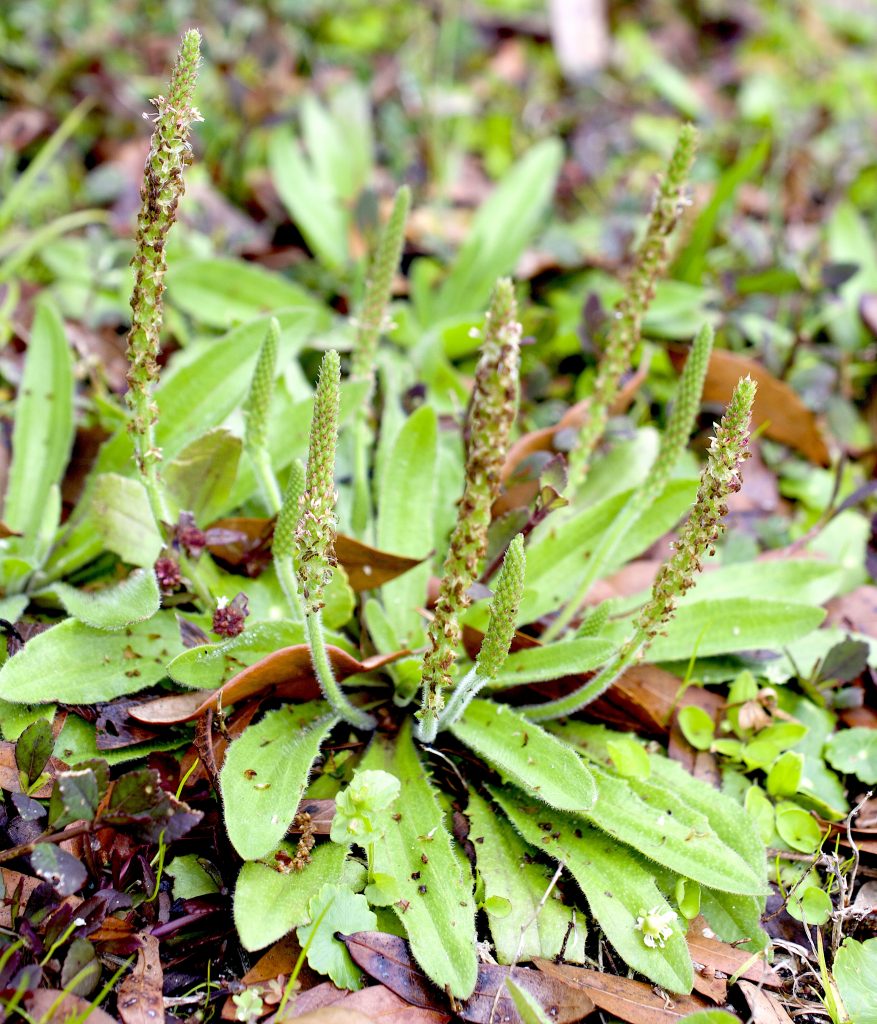
Dwarf Plantain, one of several Plantagos found locally. Photo by Green Deane
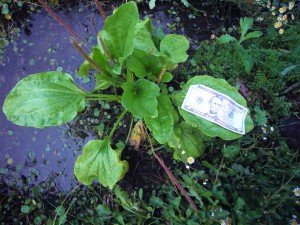
Plantago rugulii is a large local plantago. Photo by Green Deane
There are Plantains that look like tough bananas and there are Plantains that are low and leafy plants. They are not related. Just two different groups with the same common name. Low-growing Plantains can be native or non-native. The one pictured above is native, the Dwarf Plantain. As a genus the plants are well-known. The leaves are edible raw when young. As they age they become more bitter and stringy. Cooking makes them palatable up to a point. Then they move into the astringent medical realm. As such they are used on bites, stings and to help puncture wounds heal. The seeds are edible once produced and are the source of the commercial dietary fiber, psyllium. When finely ground and flavored the seeds are sold under the brand name Metamucil. There are numerous species of Plantagos (Plantains) with at least four common locally, P. virginiana, P. major, P. lanceolata and P. rugelii the latter which strongly resembles P. major. They are all used the same way. (P. rugelii is pink at the base of the stem.)
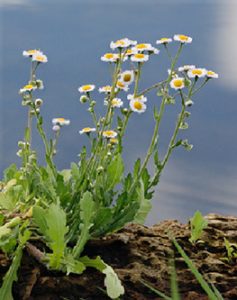
Oakleaf Flea Bane, not edible but good for pets’ beds.
One problem beginning foragers have is confusing young Oakleaf Fleabane leaves for Dwarf Plantain leaves (they are both rosette-ish, low-growing green leaves, hairy with fibrous threads in the stem.) But the Dwarf Plantain is essentially a long skinny hairy leaf with a few teeth. The Oakleaf Fleabane is much fatter, has lobes, and does resemble oak leaves found on more northern species. Of course when they blossom their difference is quite obsvious. Generally considered not edible I know a few people who have tried in once mistaking it for a Plantago. Fleabane leaves were put in pets beds to drive away fleas. You can read about the Plantains here and I have a video here.
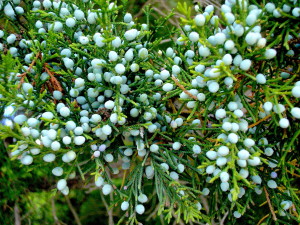
Juniper Berries change from green to blue with a powdery blush. Photo by Green Deane.
One wouldn’t think that living in a small rental house or apartment interferes with foraging but it can. The size of the kitchen can restrain the size of the oven which can limit the size of pots and pans one can use. Thus my loaf is round. The yeast and bacteria for this sourdough came from Juniper Berries which are really cones. Some were collected in West Palm Beach, others near Daytona Beach. Sourdough bread depends on wild yeast and lacto-bacteria. They are in all flour but different species. In theory one feeds the “starter” and the favorable yeast and bacteria outcompete unfavorable yeasts and bacteria becoming dominant.
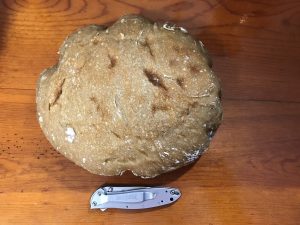
Sourdough bread started with Juniper Berries for the necessary yeast and bacteria.
Sourdough takes longer to make than regular bread because the yeast has not been bred to make a lot of rising gas quickly. The same issue comes up when the question is can one use bread yeast to make wine. Yes but… Bread yeast is bred to make a lot of gas and very little alcohol whereas wine yeast is bred to make alcohol and not a lot of gas. Wild yeast, like wild vinegar bacteria, can also throw a variety of flavors. Soudough is sour in the same way pickles, yogurt, sauerkraut, kimchi and kombucha are tart from lactic acid. It takes longer to develop the flavor of sourdough and it works well in cooler temperatures whereas bread yeast likes to be kept warm. The wild yeast can also tolerate the higher acid environment created by the bacteria. Why make sourdough? The bacteria reduces the carb load, alters the gluten, increases B vitamin use, and reduces phytates by some 70%. Phytates are the largest group of anti-nutrients in regular bread. Thus compare to regular bread sourdough allows more mineral absorption from the bread. It also increases prebiotic and probiotic-like properties. I took a couple of tablespoons of old blue Juniper “berries” and put them in non-chlorinated sugar water for a day then used that water when making my starter. (If you let tap water sit for a day it loses its chlorine.)
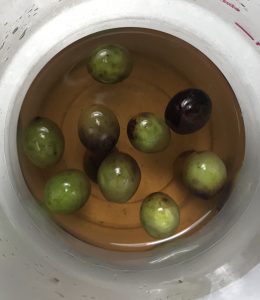
Soaking Foresteria fruit. Photo by Green Deane
The Foresteria experiment continues. We are halfway through the brining period (basically to reduce the bitter tannins in the fruit.) I know consuming a couple of berries off the tree does not cause acute toxicity (meaning immediate) but I have no idea about possible long term effects. I have eyed Foresteria berries for years knowing they are in the Olive family. One species, F. neomexicana, New Mexico Privit, Desert Olive, was eaten as were the fruit of F. pubescens. They are all bitter which is why curing them like olives occurred to me. They are soaking in a 10% brine solution with the solution being changed every week for a month. As with any brining the fruit are kept covered by the solution by a glass plug which conveniently fits into a used Dunkin Donut ice coffee cup.

Henry Wadsworth Longfellow, age 48 in 1855.
If Longfellow had lived elsewhere — say Europe — he might have penned in his famous poem: “Under the shedding Sycamore tree the village smithy stands.” As it was Longfellow wrote about the mighty American chestnut which sadly because of a blight is nearly no more. And while mentioning Longfellow take a look at his picture on the left. Most of the photos of him show an old bearded man. This was taken when he was much younger, in 1855, when photography was young, too. And unlike other pictures from the time he’s not posing like a stature. It’s more natural and gives us a glimpse of the man and personality. There’s a bit of destiny in Longfellow’s eyes. Maybe he sensed photographs would replace paintings and he wanted to look across time at us, or, us him. What did he do right after the photo was taken? Go out to dinner because he was already dressed up? Or tell the photographer he’s pay him for the (then) expensive photo next week when one of his new poems sold? When I see old photos like this I wonder what the next moment was like, when they broke pose and went on with living. Photos are frozen slivers of time.
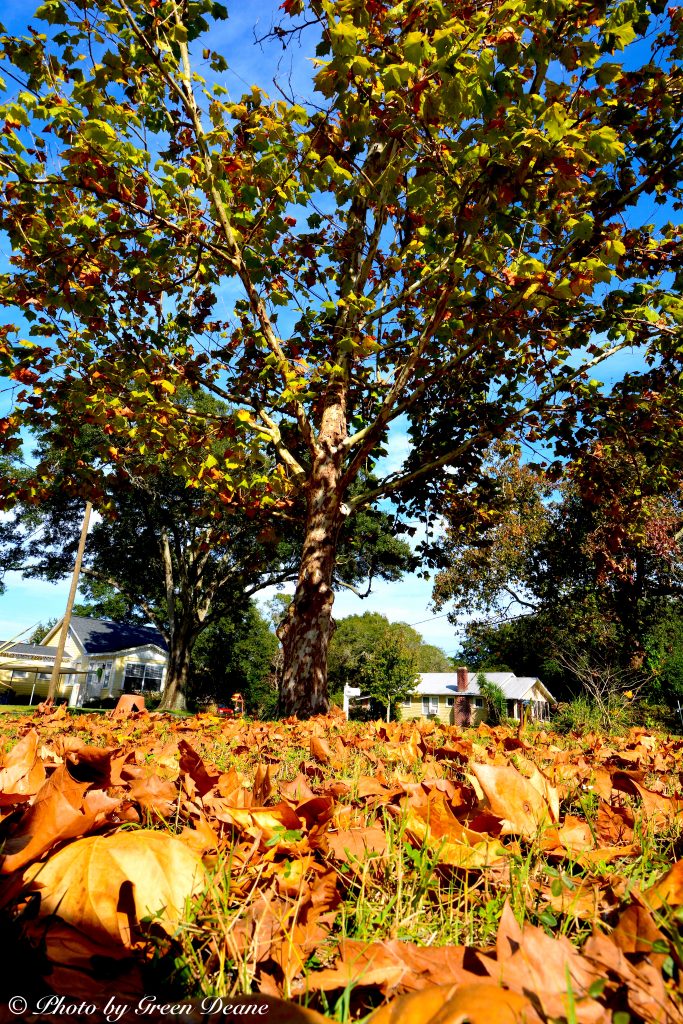
Unlike Longfellow’s chestnut tree the Sycamore gets a bad rap because of what you see in the picture right, leaves…. lots of large leaves in (my) yard. To me it’s attractive fall colors and in time more stuff for the compost pile. But, it’s the bane of many homeowners who want carefree landscaping. Sycamores, however, are forager friendly. The sap is drinkable and one could make a syrup out of it if one wanted to spend the time and energy. The sap tastes like slightly sweet water, and it is already filtered by the tree so also quite safe to drink. If you boil it down like maple sap it tastes like butterscotch. The wood is inert so it can be used in a variety of ways with food or cooking, from skewers over the campfire to primitive forks et cetera. To read more about the maligned Sycamore go here.
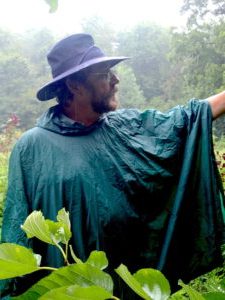
Classes are held rain, shine or cold (but not during hurricanes.)
Foraging Classes: Last Saturday in Gainesville we dug up five winged yam roots. Sunday in Melbourne we found some groundnuts and enjoyed some sumac berries This weekend both classes are near the west coast, Port Charlotte Saturday, Sarasota Sunday. Maybe the bitter cold won’t get that far south.
Saturday January 29th, Bayshore Live Oak Park, Bayshore Drive. Port Charlotte, meet at the parking lot at Bayshore and Ganyard, 9 a.m. to noon.
Sunday January 30th, Red Bug Slough Preserve, 5200 Beneva Road, Sarasota, FL, 34233. 9 a.m. to noon. Meet at the playground.
Saturday February 5th, Mead Garden: 1500 S. Denning Dr., Winter Park, FL 32789. Meet at the bathrooms. 9 a.m. to noon.
Sunday February 6th, John Chestnut County Park: 2200 East Lake Road, Palm Harbor, FL 34685. Meet at the trail head of the Peggy Park Nature Walk, pavilion 1 parking lot. 9 a.m. to noon.
For more information, to pre-pay or sign up go here

Green Deane videos are now available on a USB.
My nine-DVD set of 135 videos has been phased out and replaced by a 171-video USB. The USB videos are the same videos I have on You Tube. Some people like to have their own copy. The USB videos have to be copied to your computer to play. If you want to order the USB go to the DVD/USB order button on the top right of this page or click here. That will take you to an order form. Or you can make a $99 donation, which tells me it is for the USB (include a snail-mail address.) I’d like to thank all of you who ordered the DVD set over the years which required me to burn over 5,000 DVDs individually. I had to stop making them as few programs now will read the ISO files to copy them.

Green Deane Forum
Want to identify a plant? Perhaps you’re looking for a foraging reference? You might have a UFO, an Unidentified Flowering Object, you want identified. On the Green Deane Forum we — including Green Deane and others from around the world — chat about foraging all year. And it’s not just about warm-weather plants or just North American flora. Many nations share common weeds so there’s a lot to talk about, such as the one to the left. There’s also more than weeds. The reference section has information for foraging around the world. There are also articles on food preservation, and forgotten skills from making bows to fermenting food. Recent topics include: California Wild Mushroom Parties, A Good Reason To Eat Wild Garlic, Black Walnuts and Amaranth, Sea Salt and Plastic, Wild Mustard? Heavy Metals. Oriental Persimmons. What is it? Pine Cough Drops and Needles, Skullcap, Malodorous Plant? Another NJ Tree, Maypop? Roadside Plant, Unknown in Sudan, Please Help Identify, and Preserving Prickly Pear Bounty. You can join the forum by clicking on the button on the upper right hand side of this page.
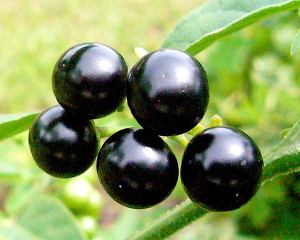
The Black Nightshade has edible ripe berries. Photo by Green Deane.
I had a friend who thought of himself as an outdoorsman thus beyond needing to study edible plants. Many years ago he called me one day asking “how do I get the seeds out of the pigweed berries.” I knew there was a problem immediately. Our local “pigweed” does not have berries but our local nightshade does. Our “pigweed” is an Amaranth and has seed spikes. About the size of fingers or more they are covered with tiny flowers that produce a multitude eye-of-the needle seeds, tan to black. No berries involved at all. Conversely the nightshade produces a cluster of black shiny berries on one small stalk (photo to right.) It does have a lot of seeds inside the berries. So I thought I had better ask him why he wanted the seeds before I told him him the Amaranth didn’t have berries but the nightshade did. He wanted to grow some in his yard. They had been steaming the leaves and eating them like spinach! When I got done explaining he said “then that’s why we’ve all been getting headaches after eating the leaves.” Indeed. The leaves of this particular nightshade are edible but they must be boiled in one or two changes of water, not steamed.
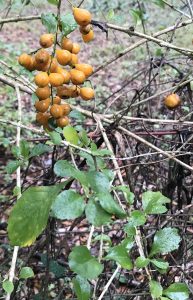
Golden Dewdrop is not edible but might have herbal applications. Photo by Green Deane
The plant to left is toxic and has several botanical names though a common on describes it well, Golden Dewdrop. Botanically it is Duranta repens, D. plumieri and D. erecta. We saw the species during our foraging class in Gainesville Saturday. It’s been called a vine-like shrub, some varieties are spiny. The non-edible fruit is bitter. Julia Morton, the grand botany professor of the University of Miami, wrote the fruit has killed children in Queensland, Australia, and sickened a Hialeah Florida girl in May 1966. She was hospitalized in a state of confusion and drowsiness but fully recovered the next day. An Australian government website about children’s health says “If eaten, the fruit can cause gastro-intestinal irritation, vomiting and diarrhea.” One research paper reports extracts of dried D. erecta leaves was effective at killing roundworms. The same research found Lantana leaf extract was also effective. A second study says Duranta leaf extract might be “a promising source of herbal medicine for the management of benign prostatic hyperplasia.”
And I have added a new article to the website, Soapberry.
This is my weekly newsletter #492. If you want to subscribe to this free newsletter you can find the sign-up form in the menu at the top of the page. My website, EatTheWeeds.com, which is data secure, has over 1500 plants on it in some 428 articles. I wrote every one myself, no cut and paste.
To donate to the Green Deane Newsletter click here.

